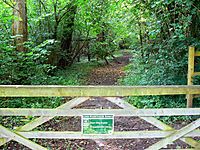Lower Woods facts for kids
| Site of Special Scientific Interest | |

Gateway and path at Lower Woods Nature Reserve
|
|
| Area of Search | Gloucestershire |
|---|---|
| Coordinates | 51°35′13″N 2°22′23″W / 51.587°N 2.373°W |
| Interest | Biological/Geological |
| Area | 280.1 hectare |
| Notification | 1966 |
Lower Woods is a very special place in South Gloucestershire, England. It covers about 280 hectares, which is like 700 football fields! It's known as a Site of Special Scientific Interest (SSSI) because of its amazing plants, animals, and rocks.
This area was first recognized as important in 1966. It's one of the biggest and oldest woodlands in the southwest of England. The Gloucestershire Wildlife Trust helps to look after it as a nature reserve.
Lower Woods is made up of 23 smaller woods and areas of coppice (where trees are cut back to grow new shoots). These areas have kept their old boundaries for hundreds of years. There are also over 60 miles of paths and wide grassy tracks to explore.
The Little Avon River flows right through the middle of the woods. The soil here is damp clay, which is perfect for the many different trees and plants that grow. Next to Lower Woods, you'll find Yarley Meadows, which is also an SSSI.
Contents
Geology: Rocks and Fossils
Lower Woods is a great place to learn about Earth's history. You can see layers of clay, shale, and limestone rocks here. These rocks also contain "bone-beds," which are layers with lots of fossils.
These rocks were formed about 200 million years ago. Back then, this area was covered by a shallow sea! Scientists have studied these rocks for over 150 years. They've found many fossil fish in the shales. You can also find special types of rock like "Landscape Marble" here.
The Woodland: Trees and Shrubs
The trees in Lower Woods are very old. Many parts of the woodland are managed using a traditional method called "coppice-with-standards." This means some tall trees, like oak and ash, are left to grow big. Smaller trees and shrubs, like hazel, are regularly cut back. This helps new shoots grow and keeps the woodland healthy.
You'll find many other types of trees and shrubs too. These include field maple, holly, goat willow, spindle, wild privet, midland hawthorn, and guelder-rose. Look out for the wild service tree; it's a special sign that this is a very old woodland. Near the river, you'll see alder trees. Some parts of the wood have grown into a tall, dense forest.
Woodland Flowers
Lower Woods is full of beautiful flowers, especially in spring and summer. When you walk through the woods, you might see carpets of bluebells and wood anemones. Other common flowers include early-purple orchid, primrose, ramsons (also known as wild garlic), common dog-violet, and yellow archangel.
Some rarer flowers also grow here. Keep an eye out for meadow saffron, herb-paris, common cow-wheat, bitter-vetch, and violet helleborine. The grassy paths are home to flowers like betony, devil's-bit scabious, saw-wort, common spotted-orchid, greater knapweed, greater butterfly-orchid, cowslip, and yellow-rattle. In damper areas, you might spot lesser spearwort, ragged-robin, marsh ragwort, and brooklime.
Animals of Lower Woods
Lower Woods is a fantastic home for many animals. You might be lucky enough to see a common dormouse or a lesser horseshoe bat. These are both special animals that need safe places to live.
Many birds also live here. The woods are very important for nightingales, known for their beautiful songs. Other birds you might hear or see include woodcock, lesser spotted woodpecker, wood warbler, tawny owl, and turtle dove.
The open, sunny areas are perfect for butterflies. Look for amazing species like the white admiral, purple hairstreak, silver-washed fritillary, dingy skipper, and brown argus.
Conservation Efforts
People work hard to protect Lower Woods. The main goals are to keep the grassland areas healthy and to continue the traditional coppice management. They also remove plants that don't naturally belong here, like certain types of conifer trees and poplar. Keeping the old paths clear helps to show the ancient banks and ditches that mark the woodland's history.

